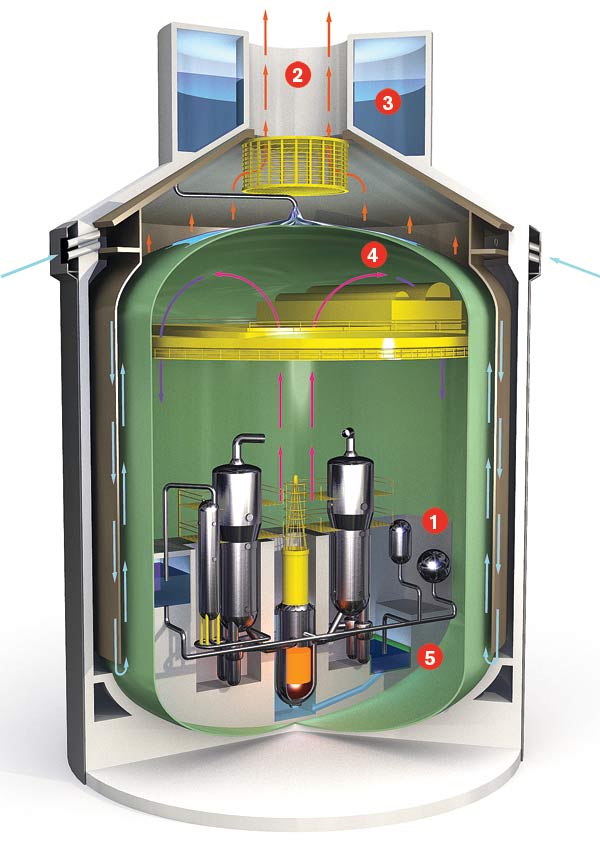New Nukes
For more than 30 years, no one has begun construction on a new nuclear reactor in the U.S. But amid growing concern about energy supplies, the U.S. Nuclear Regulatory Commission (NRC) has registered applications for licenses to build 25 new reactors since July 2007.
Two of the reactor designs specified in the applications feature passive safety systems, which are activated by natural forces and are intended to remove the risk of operator error or malfunctioning electronics. Of these, only one has been approved by the NRC: the Westinghouse Advanced Passive 1000, or AP1000 (below). The first AP1000 is likely to be built in China, where construction is scheduled to start in March 2009.
A second design, from GE Hitachi, takes passive safety even further, eliminating pumps and relying on natural circulation of water and steam for cooling during normal operation. The reactor has yet to be approved by the NRC, but GE Hitachi says that it has been selected by four U.S. utilities for “potential projects” and is under consideration in Europe.

In Westinghouse’s AP1000 reactor, if a pipe leading to the reactor vessel bursts and releases radioactive steam into the steel reactor containment (green), several emergency systems are activated automatically.
1. As steam escapes, falling pressure within the reactor’s pipes causes a backup tank to send water to the reactor. If the pressure continues to fall, a second backup tank releases its contents.
2. If the containment grows hotter, it heats the air above it, which exits through an aerial opening, drawing in cool air (blue arrows) from outside.
3. Water to cool the containment is drawn down by gravity, eliminating the need for pumps.
4. Rising steam (pink arrows) is cooled and condenses, falling back (purple arrows) to the floor.
5. A sump pumps water from the containment floor back into the system. If initial safety measures fail to stabilize the reactor core, the sump works in reverse, flooding the reactor vessel with water.
Credit: John Macneill
Passive Activity: Passive-safety reactors predominate among new applications

Keep Reading
Most Popular
Large language models can do jaw-dropping things. But nobody knows exactly why.
And that's a problem. Figuring it out is one of the biggest scientific puzzles of our time and a crucial step towards controlling more powerful future models.
The problem with plug-in hybrids? Their drivers.
Plug-in hybrids are often sold as a transition to EVs, but new data from Europe shows we’re still underestimating the emissions they produce.
How scientists traced a mysterious covid case back to six toilets
When wastewater surveillance turns into a hunt for a single infected individual, the ethics get tricky.
Google DeepMind’s new generative model makes Super Mario–like games from scratch
Genie learns how to control games by watching hours and hours of video. It could help train next-gen robots too.
Stay connected
Get the latest updates from
MIT Technology Review
Discover special offers, top stories, upcoming events, and more.